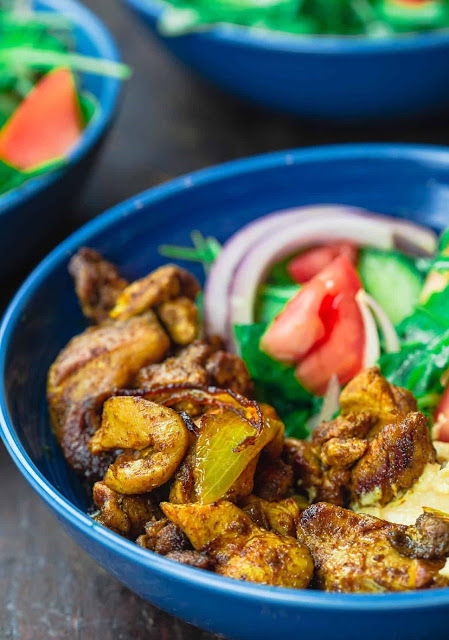These iconic, fluffy sesame bagels called Ka'ak Al Quds are found all over the streets of Jerusalem--traditionally made in wood-fire ovens and sold on street carts. Reem writes, "The men push their ka'ak-laden wooden carts through the streets shouting 'kaaaaa'aaaaak' and everyone from schoolchildren to workers to store owners--even tourists--gathers around for these delicious and filling breads."
These do not have much in common with New York-style bagels which are round, doughy, and dense. Jerusalem bagels are thinner oval-shaped bagels that are soft, airy, and less doughy with a slight sweetness, thanks to the honeyed sesame topping.
- 4 ½ cup all-purpose flour or white bread flour
- 2 tablespoon sugar
- 2 teaspoon salt
- 1 ½ cups whole milk (or unsweetened almond milk for vegan option) warm
- 1 tablespoon active dry yeast fast-action
- 1 teaspoon baking powder
- Olive oil
For the sesame coating
- 1 cup sesame seeds I used raw white sesame seeds
- 1 to 2 tablespoons honey
INSTRUCTIONS
Mix and knead the dough. Put the flour, sugar, salt, milk, yeast, and baking powder in the bowl of a freestanding mixer fitted with the dough hook (do not add the olive oil yet). Mix on medium speed until the dough comes together forming a soft and pliable ball. If you do not have a mixer, mix the dough ingredients in a large bowl and knead by hand (you can knead on a clean surface if that is easier for you) until the dough is smooth and pliable (it will take a bit longer this way, but will work). You are looking for a soft, elastic but robust dough.

Allow the dough to rise. Rub the dough with a little bit olive oil and place it in a large bowl. Cove with plastic wrap or a damp kitchen towel. Set aside in a warm spot for 1 hour; the dough should rise and double in size.
Work on the sesame coating. In a large shallow baking dish, combine the sesame seeds and honey with 1 tablespoon of water. Mix, adding a bit more water as necessary, until you have a wet mixture that is neither too sticky and thick that it clumps up, nor too thin (you’ll need to be able to coat the dough in the sesame seeds and have them stick).
Divide the dough and make 6 equal pieces.

Punch down the risen dough and divide it into 6 portions that are equal in size. Place them on a lightly floured work surface. Roll and stretch each piece into a log (about 8-12 inches long), then attach the ends together to form a ring (you should end up with 6 rings). Gently stretch out the rings to form ovals rather than circles. Set aside for 15 minutes to rest.
Heat the oven to 450 degrees F (gas mark 8).

Coat the rings or bagels with the sesame coating. Take each dough ring and dip it in the sesame mixture. Set it on a large baking sheet. Repeat with the remaining rings. Allow the rings to rest on the baking sheet one more time for 10 minutes.
Bake. Place the baking sheet (or sheets) in the heated oven and bake for 15 to 20 minutes or until the bagels cook through and turn a deep golden color.


Allow the dough to rise. Rub the dough with a little bit olive oil and place it in a large bowl. Cove with plastic wrap or a damp kitchen towel. Set aside in a warm spot for 1 hour; the dough should rise and double in size.
Work on the sesame coating. In a large shallow baking dish, combine the sesame seeds and honey with 1 tablespoon of water. Mix, adding a bit more water as necessary, until you have a wet mixture that is neither too sticky and thick that it clumps up, nor too thin (you’ll need to be able to coat the dough in the sesame seeds and have them stick).
Divide the dough and make 6 equal pieces.

Punch down the risen dough and divide it into 6 portions that are equal in size. Place them on a lightly floured work surface. Roll and stretch each piece into a log (about 8-12 inches long), then attach the ends together to form a ring (you should end up with 6 rings). Gently stretch out the rings to form ovals rather than circles. Set aside for 15 minutes to rest.
Heat the oven to 450 degrees F (gas mark 8).

Coat the rings or bagels with the sesame coating. Take each dough ring and dip it in the sesame mixture. Set it on a large baking sheet. Repeat with the remaining rings. Allow the rings to rest on the baking sheet one more time for 10 minutes.
Bake. Place the baking sheet (or sheets) in the heated oven and bake for 15 to 20 minutes or until the bagels cook through and turn a deep golden color.

NOTES
- The sesame seed and honey mixture is likely more than you'll use here. If you want, you can start with ½ cup of sesame seeds and 1 tablespoon of honey.
- You can freeze baked Jerusalem bagels for up to 1 month. Reheat in the oven (from frozen) before serving.
































